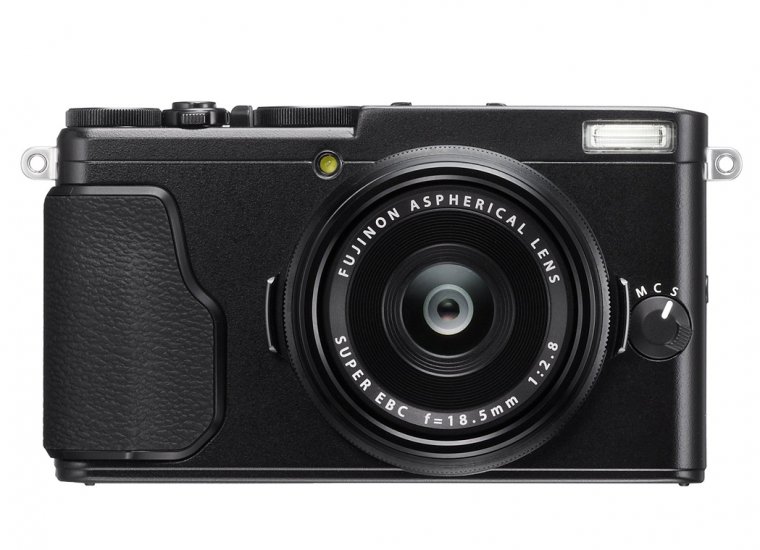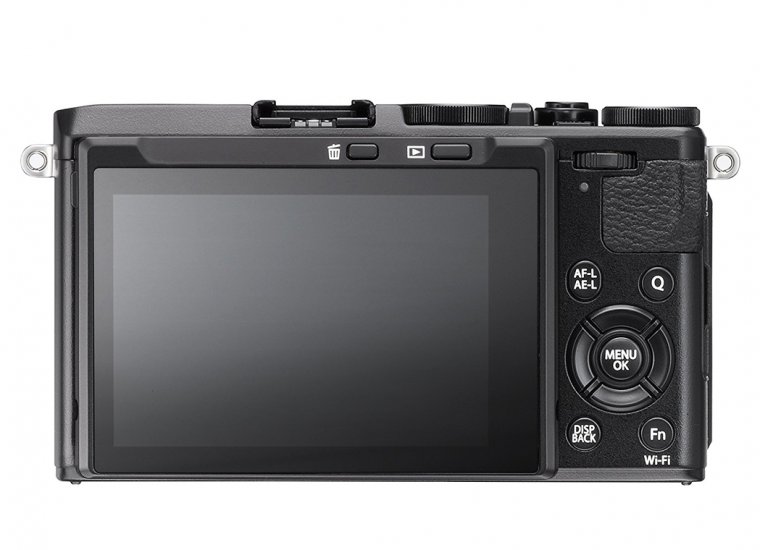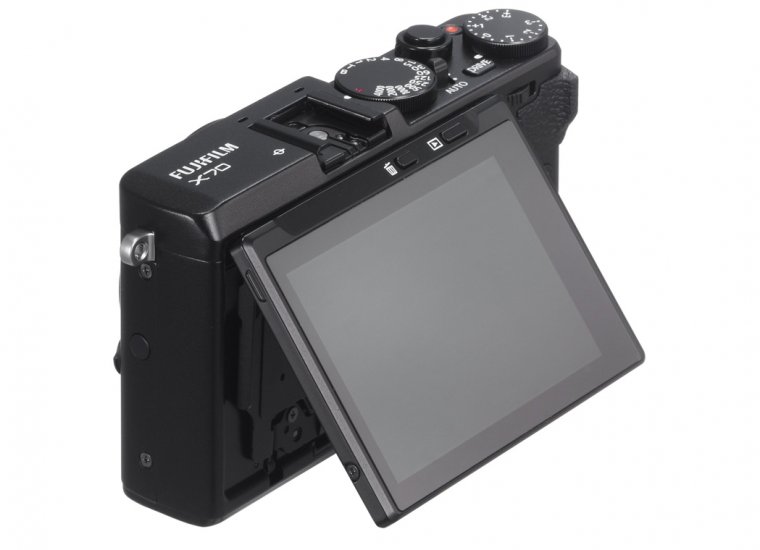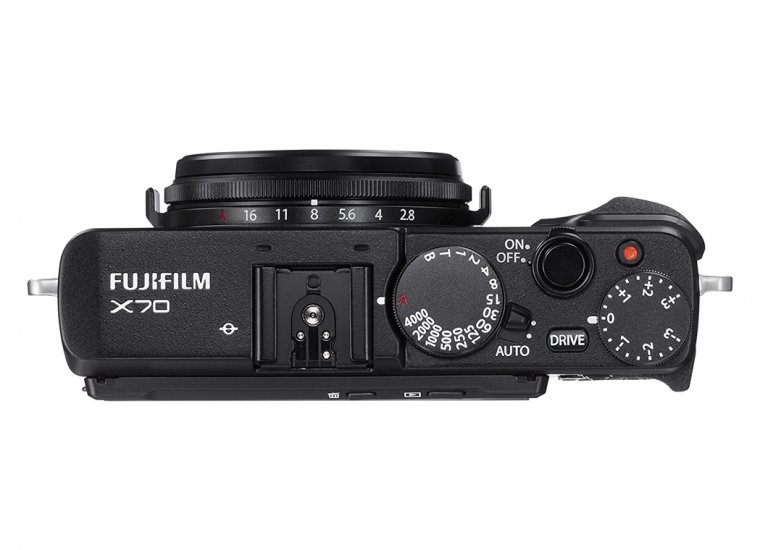
It’s always interesting to review a new product coming from Fujifilm and the case is no different this time. Today, at our hands, we have one of the company’s newer products, the Fujifilm X70. It’s one of these cameras that tries to blend a traditional mirrorless camera boasting a large APS-C sensor with a fixed lens turning it essentially into a compact camera. It’s an interesting hybrid of a camera like Canon Powershot G3X that should appeal to many different types of photographers, but mostly to those seeking a capable street camera or look for something that can get them high-quality images, but without the hassle of having to change lenses and invest in them.
The X70 promises to do just that, with a high-quality body, a plenty of manual controls, a touchscreen and a 28 mm equivalent wide angle lens that should provide just the right field of view for everyday shooting. However, it’s not a camera targeted especially at professional users, since they will surely miss the lack of a viewfinder, so those people should look further down the Fuji’s range and take a look at one of their X100 series of cameras. So, let’s take a quick look at what the X70 really has to offer.
Table of Contents
We’ve already mentioned that the body of the X70 is entirely made out of aluminum and that is immediately noticeable when you take the camera in your hands. It really feels like a well-assembled product, but at the same time, it feels light enough to be used for longer periods of time without becoming a strain on your hands. The grip on the front isn’t the biggest we’ve seen, but it still helps a lot to help you hold the camera more securely without the fear of suddenly dropping it. The thumb rest on the back of the camera is of perfect size and serves its purpose. The X70 also promises to bring a lot of manual controls for a camera of its size and it’s time if it really has enough to it to satisfy the needs of advanced photographers who are used to having all of the most important settings available to them just with the press of a button or a turn of a dial. The control scheme itself doesn’t look out of place in any way, but let’s see how usable all of those controls really are.
Starting from the front we find the focus assist light, flash unit and a little dial that’s used to switch between Single-point AF, continuous AF, and manual focus. The lens itself also comes with both the aperture and the focus dial and it really looks like something taken straight from an old-school rangefinder camera. Interestingly enough, unlike most of the cameras we’ve tested, the X70 has one customizable Fn button located on its left side. It quite an unusual place for a button, but it still feels quite ok to use despite its strange positioning. The right side of the camera only holds the protective flap for all the ports and that’s it. Things begin to get interesting when you look at the camera from the top. Here we find the hot shoe and stereo microphones, a shutter speed dial that also has a T, B and Auto modes on it, Drive and direct video record button, a shutter button that also has a lever on it for powering on the camera and also the exposure dial that can adjust exposure from -3 to +3 EV.

The back of the camera is almost completely reserved for the 3-inch touchscreen and there are only small Delete and Playback buttons found above it. Looking at the right side reveals use the rear control dial that’s also clickable, AF-L/AE-L, Q menu, Fn/Wi-Fi and Display/Back buttons and the four-way navigation controller with a Menu/Ok button located in its center. You really can’t deny the fact that the X70 is one impressive camera when it comes to the sheer number of manual controls and only the biggest enthusiast may find a problem with it. Everyone else will never feel they are having a hard time accessing any of the most important functions. While you can’t move through the interface or changing settings with the help of the touchscreen, it still has some important functionality to it that rounds up the whole experience of using the X70. Its main function is to control your AF point and to tap and hold to shoot. It does so with is and it’s almost the same experience as taking a photo with a smartphone. Its secondary function is the ability to swipe through your photos and zoom in and out of them with a familiar pinch gesture. We would still like to have the ability to control the camera with our touch, but the included functionality is still very useful to have and the X70 already has enough physical controls to make it easy to use even without the use of a touchscreen.

Luckily it really makes use of its physical controls when it comes to customization, as you can change the function of up to 8 different buttons, something that is rarely seen on a camera of its class. Another great thing is that there’s no limit to what you can assign to those buttons, meaning each of them has the same level of customization. There are 23 different functions you can assign to those buttons and those can and some of those are the ISO, image quality, dynamic range, white balance, flash mode, depth of field preview and so on. Other than the strange placement of the Fn button located on the left side of the camera, we really have no complaints about Fuji’s approach to customization on the X70 and it really gives you a lot of possibilities of programming the camera to act the way you really want it to. We should also mention that the manual focus ring on the lens can also be reprogrammed to access different features, more precisely, four of them: you can either set it to change white balance or ISO, enable Digital Teleconverter or to switch between the included Film Simulation modes. The Digital Teleconverter itself is an interesting feature. Instead of only cropping into the image to give you a tighter field of view, it also allows you to still get full resolution shots with the help of interpolation.
The image quality at 35 mm is pretty acceptable, while the drop in sharpness and the increased amount of artifacts becomes really noticeable at 50 mm. If you were planning to upload your photos anywhere on the internet, then the drop in quality won’t really be noticeable and it will be a really useful feature to have in that case. If you’re planning on printing your photos, then you should only consider using the 35 mm model. You should also keep in mind that the Teleconverter can only be applied to JPEG images.

Lastly, it’s time to say a few words about the W-Fi capabilities on the X70. There are no surprises here, but also no disappointments. You get every functionality you would expect from a camera, from the ability to transfer and backup your images, to be able to remotely control via your smartphone and Fuji’s Remote Camera application. You also get the benefit of full manual control and touch AF that works just by tapping your smartphone’s screen. Other than missing the viewfinder and the ability to do more with its touchscreen, the X70 itself is a great package consisting of high build quality, a lot of manual control and enough customization to satisfy most of the photographers out there. Now, that we’ve got that covered, it’s time to take a look at another important aspect of every camera, its performance.
The hybrid AF system in the X70 works quite well for what it is. It offers both contrast and phase detect points, so it’s quite versatile when it comes to focusing in different lighting conditions and different situations overall. In good light or when there are moving subjects in your frame it switches to phase detect mode, but when you’re shooting still subjects or in low light, it switches to contrast detect mode to ensure that the accuracy is the best it can be. It does really on the contrast detect AF a little more than we’d like, but it still leads it to a better than average performance in all situations. Focusing is also very impressive for close-up shots as it doesn’t need a dedicated macro mode like many other cameras and it detects focusing distance quite fast by itself thus saving you the time of having to activate an additional mode before taking your shot. There’s also the benefit of having touch AF, which helps for those occasions where you’re shooting in difficult angles or you need to manually focus on a specific subject. The available focusing modes are your usual affair for a Fuji camera and these are the Zone AF, Wide/Tracking and Face/Eye detection. Subject tracking performance is nothing to write home about, but while not being very fast it’s still quite accurate for most occasions.

Due to the very capable processor providing it with all the necessary power, the X70 performs admirably in all the daily tasks you put it through. There are no noticeable hiccups or stuttering to speak about during use and you should be very happy while operating it. The burst rate of 8 fps is also quite a respectable speed for a camera of its type and it also works when the continuous AF is enabled. The only thing that doesn’t impress much is the buffer size. You are allowed take around 15 JPEGs or 7 RAW files before it needs to clear. Honestly, that isn’t such a bad performance when you consider the fact that the X70 is more catered to street shooting than anything else and it that case it should perform well enough for most street photographers. Battery life is something that could be considered its strength, since getting around 330 shots from a camera that isn’t very large, to begin with, should be enough to get you through a solid day of shooting. So, the X70 isn’t may not be the best performer among compact cameras, but it’s still a very capable one, especially when you consider the fact that it doesn’t cost nearly as much as some other advanced compact cameras on the market.
We all know that video recording is rarely a strong selling point for any of Fuji’s cameras, so we will keep our expectations in check for this one. First, there is no 4K recording available and you only get 1080p mode at 60 fps (or lower if that’s your thing). You get full manual control of exposure, microphone level adjustment and the 2.5 mm microphone jack and also the ability to activate continuous AF. The autofocus itself is limited in a way that you can’t refocus manually while the recording is in progress; a serious limitation for anyone that was expecting to use the X70 for something more than a casual video camera. Not that you would really want to since it doesn’t have the necessary image quality to become one. While the recorded footage is quite clean of any noise up until the highest ISO values and the colors are nice and accurate, the amount of detail isn’t the best we’ve seen on a compact camera. You will also easily notice artifacts in your everyday videos, especially when there’s something of solid color in your frame. It really seems that the special pixel arrangement of X-Trans sensors really hurts video performance for some reason. Luckily, this doesn’t seem to be the case for stills quality, which we will find about in the very next category of this review.
Finally, we’ve reached the part of the review where we can freely throw words of praise at the X70, without the need to dig in deeper into its performance. The sensor inside of it is already well-known for its imaging prowess and for being able to deliver excellent image quality in all situations. Color accuracy is spot on and images have just the right amount of saturation to them. Dynamic range is also very good and you can really pull a lot of detail from overexposed highlights or underexposed shadows if the need arises. Noise performance is simply excellent and the images up until an ISO of 3200 are almost completely free of any noise. You can even get some usable shots at ISO of 6400 or 12800 if you are careful with your exposure and you know your way around in post processing. If you plan on sticking with only shooting JPEGs, then you can take advantage of interesting Film Simulation modes that are now included in almost every Fuji camera. Some of these modes are Provia, Velvia, Astia and Classic Chrome. There are also some other modes that are more traditional like different combinations of Monochrome or Sepia modes. You really get a lot of options when shooting with the X70, but most importantly you get the still image quality that could easily be considered to be one of the best in class.

Noise performance is simply excellent and the images up until an ISO of 3200 are almost completely free of any noise. You can even get some usable shots at ISO of 6400 or 12800 if you are careful with your exposure and you know your way around in post-processing. If you plan on sticking with only shooting JPEGs, then you can take advantage of interesting Film Simulation modes that are now included in almost every Fuji camera. Some of these modes are Provia, Velvia, Astia and Classic Chrome. There are also some other modes that are more traditional like different combinations of Monochrome or Sepia modes. You really get a lot of options when shooting with the X70, but most importantly you get the still image quality that could easily be considered to be one of the best in class.
You really can’t argue with the fact that the Fujifilm X70 is one interesting camera. It’s somewhat of a blend between the classic rangefinder camera and a modern compact camera, but albeit with a few changes thrown in here and there. What separates it the most from a rangefinder camera is its lack of a viewfinder, like the one found on the Fuji’s X100 series of cameras. It’s really not a surprise that it doesn’t have one since it’s a lower tier camera and we really don’t feel the need to complain about it.
It’s really not a surprise that it doesn’t have one since it’s a lower tier camera and we really don’t feel the need to complain about it. While it also lacks a good video mode, it still does a lot of things so well that we can easily forgive it for that omission. It sports a well-built body with a lot of manual control, a great screen, decent autofocus system and burst rate, respectable performance, and battery life, a lens with a useful focal length for everyday shooting and image quality that shouldn’t leave anyone indifferent.
While it won’t impress many professionals with what it has to offer, it will still bring a lot of people joy and a different perspective in photography that the one you would get from your average compact or even a mirrorless camera. And it does so without any compromise on photo quality, something that every photographer should appreciate it.
Comments (0)
There are no comments yet.